
Nampeyo was a Hopi-Tewa potter who lived on the Hopi Reservation in Arizona. Her Tewa name was also spelled Num-pa-yu, meaning "snake that does not bite". Her name is also cited as "Nung-beh-yong," Tewa for Sand Snake.

Maria Poveka Montoya Martinez was a Puebloan artist who created internationally known pottery. Martinez, her husband Julian, and other family members, including her son Popovi Da, examined traditional Pueblo pottery styles and techniques to create pieces which reflect the Pueblo people's legacy of fine artwork and crafts. The works of Maria Martinez, and especially her black ware pottery, are in the collections of many museums, including the Smithsonian, the Metropolitan Museum of Art, the Denver Art Museum, and more. The Penn Museum in Philadelphia holds eight vessels – three plates and five jars – signed either "Marie" or "Marie & Julian".

Lucy Martin Lewis was a Native American potter from Acoma Pueblo, New Mexico. She is known for her black-on-white decorative ceramics made using traditional techniques.
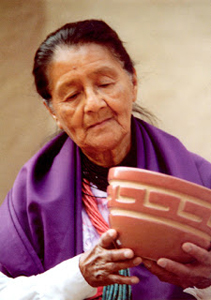
Maria Margarita "Margaret" Tafoya was the matriarch of Santa Clara Pueblo potters. She was a recipient of a 1984 National Heritage Fellowship awarded by the National Endowment for the Arts, which is the United States government's highest honor in the folk and traditional arts.
Bhalil is a town in the north of Morocco.
Mark Hewitt is an English-born studio potter living in the small town of Pittsboro, North Carolina outside of Chapel Hill, North Carolina. In 2015 he received a United States Artist Fellowship, for contributions to the creative landscape and arts ecosystems of the country. He was a finalist for the 2015 Balvenie Rare Craft Fellowship Award, for contributions to the maintenance and revival of traditional or rare craft techniques. In 2014 he was awarded a Voulkos Fellowship at the Archie Bray Foundation for the Ceramic Arts in Helena, Montana, for outstanding contributions to the ceramic arts.
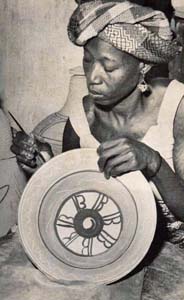
Ladi Kwali or Ladi Dosei Kwali, OON NNOM, MBE was a Nigerian potter, ceramicist and educator.
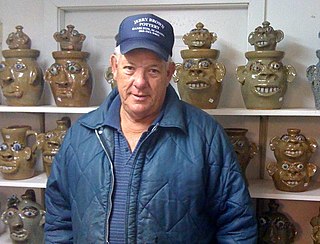
Jerry Dolyn Brown was an American folk artist and traditional stoneware pottery maker who lived and worked in Hamilton, Alabama. He was a 1992 recipient of a National Heritage Fellowship from the National Endowment for the Arts and a 2003 recipient of the Alabama Folk Heritage Award. His numerous showings included the 1984 Smithsonian Festival of American Folklife with his uncle, potter Gerald Stewart.

Green glazed pottery of Atzompa is a style of glazed pottery, which originates in the Oaxaca, Mexico town of Santa María Atzompa. Almost all of the pottery made here is of a jade-green color, due to the lead monoxide glaze which has been traditionally applied to it.

Ceramics in Mexico date back thousands of years before the Pre-Columbian period, when ceramic arts and pottery crafts developed with the first advanced civilizations and cultures of Mesoamerica. With one exception, pre-Hispanic wares were not glazed, but rather burnished and painted with colored fine clay slips. The potter's wheel was unknown as well; pieces were shaped by molding, coiling and other methods,

Mata Ortiz pottery is a recreation of the Mogollon pottery found in and around the archeological site of Casas Grandes (Paquimé) in the Mexican state of Chihuahua. Named after the modern town of Mata Ortiz, which is near the archeological site, the style was propagated by Juan Quezada Celado. Quezada learned on his own to recreate this ancient pottery and then went on to update it. By the mid 1970s, Quezada was selling his pottery and teaching family and friends to make it and the pottery was able to penetrate the U.S. markets thanks to efforts by Spencer MacCallum and later Walt Parks along with Mexican traders. By the 1990s, the pottery was being shown in museums and other cultural institutions and sold in fine galleries. The success of the pottery, which is sold for its aesthetic rather than its utilitarian value, has brought the town of Mata Ortiz out of poverty, with most of its population earning income from the industry, directly or indirectly.
Lisa Holt and Harlan Reano are a husband-and-wife team of Pueblo potters and artists from northern New Mexico. They have been making pottery together in 1999, they use traditional Cochiti pottery techniques and create modern work.

Ceramic art is art made from ceramic materials, including clay. It may take varied forms, including artistic pottery, including tableware, tiles, figurines and other sculpture. As one of the plastic arts, ceramic art is a visual art. While some ceramics are considered fine art, such as pottery or sculpture, most are considered to be decorative, industrial or applied art objects. Ceramic art can be created by one person or by a group, in a pottery or a ceramic factory with a group designing and manufacturing the artware.
Georgia Harris was known for preserving traditional forms of Catawba pottery. A member of the Catawba Tribe in South Carolina, Harris was a recipient of the National Heritage Fellowship for her work. Although ranging centuries, the earliest records of the Catawba pottery tradition that have been obtained date back to 1702. It was this rich history that Harris was responsible for preserving, including during a time period that ranged from the 1930s to the 1960s, when the tradition suffered due to demand. Beginning when she was 9 years old Harris took a keen interest in pottery, learning from both her mother and grandmother. As time passed, Harris found herself especially captivated by the pipe-making tradition, later passing down the art to many apprentices. Harris's legacy in Catawba pottery continues past her death.

Anna Mitchell was a Cherokee Nation potter who revived the historic art of Southeastern Woodlands pottery for Cherokee people in Oklahoma. Her tribe designated her as a Cherokee National Treasure and has works in numerous museum collections including the Smithsonian National Museum of the American Indian, the Museum of Fine Arts, Boston, and the Fred Jones Jr. Museum of Art, among others.

Priscilla Namingha Nampeyo was a Hopi-Tewa potter who was known for her traditional pottery. Namingha mined her own clay and created her own pigments for her large pots. Her work is in the collection of several museums and cultural centers.
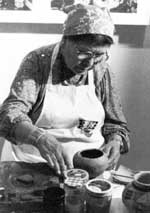
Daisy Hooee Nampeyo was a Hopi-Tewa potter. She studied at École des Beaux-Arts. Hooee taught pottery making on the Zuni reservation and helped preserve the traditional techniques she learned from her grandmother, Nampeyo.
Cecil Archibald Baugh, was a Jamaican master potter and artist.

Black-on-black ware is a 20th- and 21st-century pottery tradition developed by Puebloan Native American ceramic artists in Northern New Mexico. Traditional reduction-fired blackware has been made for centuries by Pueblo artists and other artists around the world. Pueblo black-on-black ware of the past century is produced with a smooth surface, with the designs applied through selective burnishing or the application of refractory slip. Another style involves carving or incising designs and selectively polishing the raised areas. For generations several families from Kha'po Owingeh and P'ohwhóge Owingeh pueblos have been making black-on-black ware with the techniques passed down from matriarch potters. Artists from other pueblos have also produced black-on-black ware. Several contemporary artists have created works honoring the pottery of their ancestors.
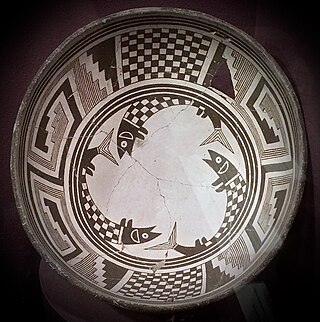
Pueblo pottery are ceramic objects made by the indigenous Pueblo people and their antecedents, the Ancestral Puebloans and Mogollon cultures in the Southwestern United States and Northern Mexico. For centuries, pottery has been central to pueblo life as a feature of ceremonial and utilitarian usage. The clay is locally sourced, most frequently handmade, and fired traditionally in an earthen pit. These items take the form of storage jars, canteens, serving bowls, seed jars, and ladles. Some utility wares were undecorated except from simple corrugations or marks made with a stick or fingernail, however many examples for centuries were painted with abstract or representational motifs. Some pueblos made effigy vessels, fetishes or figurines. During modern times, pueblo pottery was produced specifically as an art form to serve an economic function. This role is not dissimilar to prehistoric times when pottery was traded throughout the Southwest, and in historic times after contact with the Spanish colonialists.














